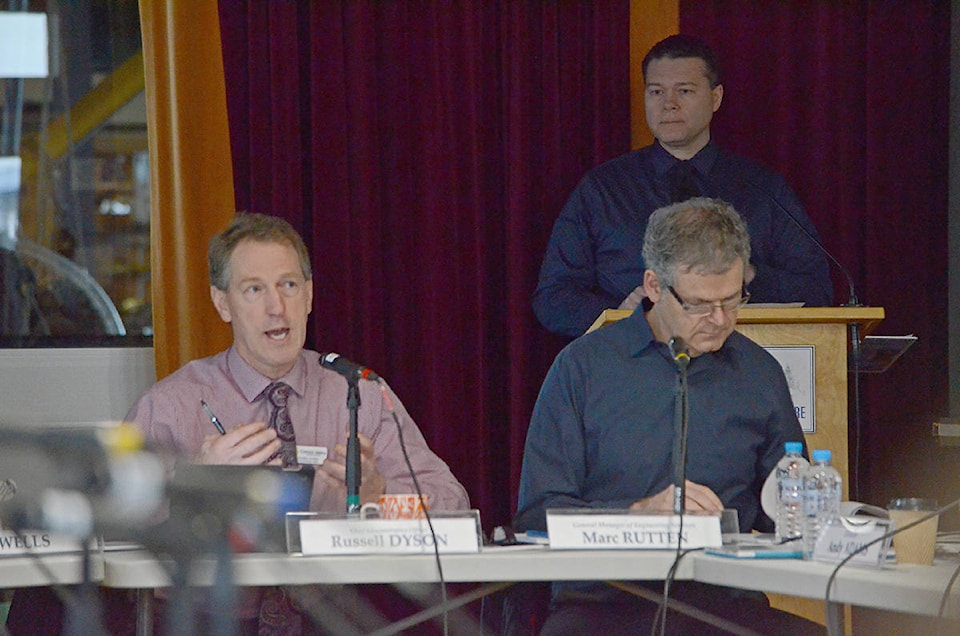Comox Strathcona Waste Management is considering an increase in tipping fees as a way to avoid further tax increases in the Comox Valley and Strathcona regional districts.
Members of the CSWM board, which includes both regional districts, had been critical of tax hikes for the coming year once again, saying they had been told in the past tipping fees would pay for service.
At the most recent board meeting, held Feb. 7 in Campbell River, senior solid waste manager Andrew McGifford presented the plan to the board.
“It was a very quick analyses of just the tipping fees and how they would be impacted,” he said.
The plan was to present the board with amounts of tip fee increases and how much they would offset tax hikes in future budgets. The current charge for municipal solid waste is $130 per tonne, or $300 a tonne if the municipal solid waste contains recyclables. With a $30 per tonne increase, this would equal $2 million, or $1 million for $15 per tonne increase. A table in an accompanying report from the meeting sets out the ramifications based on increases in $5 increments.
“With this, we have to make sure that we understand all the considerations involved in increasing the tipping fee versus doing the tax requisition increases,” McGifford said.
In recent years, this has come through tax hikes, typically in the range of an additional $2 million a year.
“We also have commitments to other stakeholders,” he added, citing haulers as well as municipal governments, which have set out the tipping fees in their financial plans.
RELATED STORY: Comox Strathcona Waste Management falls back on tax hikes
Another consideration is that increases in tipping fees could result in changing behaviour, which in turn can affect revenue. For example, McGifford said with a five per cent reduction in the volume of waste coming to the landfill, the tipping fee would need to be increased even more.
CSWM staff point out this is a work in progress and will include a review of the bylaw every two years, starting this year.
“We will seek your input on this,” said Russell Dyson, the chief administrative officer for both the CVRD and the CSWM.
The issue is not so much that tipping fees do not cover costs. Charlie Cornfield, a Campbell River council representative, stated tipping fees actually generate a profit on their own, meaning increases in either taxes or tipping fees go toward other waste management programs rather than the landfill itself.
“Generally, the landfill more than pays for itself, other than the capital costs where we have not set up a reserve,” he said, adding they should consider a reserve fund for landfill profits.
Dyson responded they should not view the landfill as a separate entity but part of the overall waste management infrastructure, which requires transportation and comes with obligations to divert waste.
“The landfill is not a profit centre…. The landfill is one component,” he said. “Ultimately, we have to raise the revenues necessary to meet our obligations.”
The challenge for CSWM is that it is faced with the high costs from closing old landfills in the Comox Valley and Campbell River in the coming years – costs that were not accounted for in the past. This means CSWM is having to make up for this lost time. At a CSWM board meeting in November, staff described costs around closing the two landfills as a drain on capital reserves.
“We are borrowing money to close landfills,” McGifford said.
“We never fully cover the cost of closing landfills in the tipping fees,” added Bob Wells, Courtenay’s mayor who chairs the CSWM board.
RELATED STORY: Comox-Strathcona waste plan update could be costly
Arzeena Hamir, who represents Area B in the Comox Valley, did not support the $30 increase in tipping fees, expressing her concern this could result in illegal dumping or waste being sent to sites outside the region – concerns that staff cited. She asked if staff could look at looking at construction waste separately in light of how much of its comes into the landfill and how much could be diverted.
“The cost and energy and time, for whatever reason, the haulers were not taking the time to divert it,” she said.
The staff report notes that at present construction waste and demolition debris account for just over 15 per cent of tipping fee revenue.
Hamir suggested construction waste tipping fees could account for revenue potentially lost through a planned organic waste diversion program.
McGifford responded that construction waste is an issue, with many businesses paying the higher tipping fees to avoid having to separate materials. He suggested revisiting this as a part of a full review of the bylaw’s fee structure.
